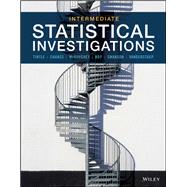Intermediate Statistical Investigations provides a unified framework for explaining variation across study designs and variable types, helping students increase their statistical literacy and appreciate the indispensable role of statistics in scientific research. Requiring only a single introductory statistics course as a prerequisite, the program uses the immersive, simulation-based inference approach for which the author team is known.Students engage with various aspects of data collection and analysis using real examples and clear explanations designed to strengthen multivariable understanding and reinforce first-course concepts.
Each chapter contains in-depth exercises which follow a consistent six-step statistical exploration and investigation method (ask a research question, design a study, explore the data, draw inferences, formulate conclusions, and look back and ahead) enabling students to assess a variety of concepts in a single assignment. Challenging questions based on research articles strengthen critical reading skills, fully worked examples demonstrate essential concepts and methods, and engaging visualizations illustrate key themes of explained variation. End-of-chapter investigations use real data from popular culture and published research studies in a variety of disciplines, exposing students to various applications of statistics in the real world. Throughout the text, user-friendly Rossman Chance web applets allow students to conduct the simulations and analyses covered in the book.








